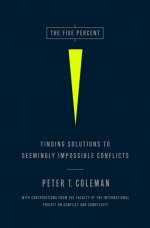Recently I had the good fortune to spend an afternoon with Peter Coleman, author of the forthcoming book, The Five Percent, Finding Solutions to Seemingly Impossible Conflicts (the link is to Amazon because you are going to want to buy this book). Coleman is the director of the International Center for International Cooperation and Conflict Resolution and Associate Professor of Psychology and Education at Columbia University.Â
Coleman leads a team whose project, “Modeling the Fundamental Dynamics of Intractable Conflict” is funded by the McDonnell Foundation. They are working together to apply ideas and methods from complexity science to what Coleman describes as “the 5 % problem“ — those 5% of intractable, destructive and enduring conflicts that persist despite application of otherwise proven conflict resolution methodology. Team members include Andrzej Nowak and Robin Vallacher, social psychologists with expertise in the application of dynamical systems to cognitive, interpersonal, group and social phenomena; Larry Liebovitch, a physicist with expertise in formal descriptions and modeling of system dynamics; and Andrea Bartoli, a social anthropologist and practitioner who specializes in international conflict and genocide prevention (descriptions are from the team’s website).Â
In the workshop I attended Coleman used his group’s findings and applied them to difficult business problems to show how we might apply the group’s emerging theory to conflict resolution in our own workplaces. Anyone who has held a leadership position knows that some problems resist solutions. And, enacting proven conflict resolution strategy seems to make some resistant problems even worse. Coleman’s work helps me understand why.
A crude oversimplification of the work is that intractable conflicts are extremely complex in nature, so complex that it is difficult to sustain a mental map of factors that influence the conflict. The brain acts to simplify the conflict, and, in fact, the tendency is to over-simplify, to reduce the conflict to a simple us/them, pro/con, I’m right/you’re wrong. The complexity of the conflict is too much to handle cognitively.  Once the conflict is simplified, opposing forces can dig in, increasing intractability.
Additionally, applying traditional problem-solving models typically means deploying a rational, planned process that focuses on activities like negotiation and mediation, methods that work in what Coleman calls “thinking in straight lines.” In thinking about problems, we generally believe that one thing leads to another, one thing causes the next thing to happen in a straight line of linear causality.Â
However, complex and intractable problems are neither reducible nor linear. They behave more like “problem systems,” systems that cannot be understood through simplification and which will not respond to linear approaches (or will respond in unpredictable ways). Coleman and his team study these conflicts as dynamical systems, with loops of interactions, hubs of agreement and disagreement, and varying positions within a landscape of attractors (patterns we fall into in our relationships that resist change).  Â
A problem solving approach begins with complicating rather than simplifying the conflict description. This can be achieved visually by “conflict mapping” (creating a picture of the factors acting on all parts of a complex problem).  Then the problem solvers can use the picture to look for hubs and actionable areas of agreement, see where influencers aggregate to help or impede resolution, and work to expand on the “hidden possibilities” for agreement and resolution that the map reveals. One of his most interesting recommendations is to “aim to alter patterns not outcomes.” Since complex problems are built with complicated loops and circuits, altering these maps, re-wiring them if you will, is a better mental image than focusing on a specific outcome. Think of the solution as changing the map, “changing the landscape” of the problem rather than “solving” the problem.  Finally, Coleman suggests “privileging emotions” when dealing with intractable conflict. Ignoring the emotional content of the conflict is a form of simplification that is unhelpful to long-term solutions.Â
I found Coleman’s thinking stimulating because traditionally we think of conflicts as having solutions, something like solving a math problem.  Thinking of an intractable conflict as system, whose stasis depends on persistent tending of a landscape of forces and factors, is proving a helpful new conceptual framework for me as I go about my work.Â
The book will be published on Tuesday. I have a copy on order.

